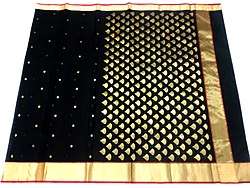Chanderi sari
 A handwoven Chanderi sari | |
| Type | Sari |
|---|---|
| Material | Silk or cotton |
| Place of origin | Chanderi, Madhya Pradesh, India |
Chanderi sari is a traditional sari made in Chanderi, Madhya Pradesh, India.[1][2][3]
History
The weaving culture of Chanderi emerged between the 2nd and 7th centuries. It is situated on the boundary of two cultural regions of the state, Malwa and Bundelkhand. The people of the Vindhyachal Ranges have a wide range of traditions. In the 11th century the trade locations Malwa, Medwa, central India and south Gujarat increased the region's importance.
The Chanderi sari tradition began in the 13th century. In the beginning, the weavers were Muslims. Around 1350, Koshti weavers from Jhansi migrated to Chanderi and settled there. During the Mughal period, the textile business of Chanderi reached its peak.
Themes and motifs
Chanderi sarees are produced from three kinds of fabric: pure silk, Chanderi cotton and silk cotton. Traditional coin, floral art, peacocks and geometric designs are woven into different Chanderi patterns. The saris are among the finest in India and are known for their gold and silver brocade or zari, fine silk, and opulent embroidery.
See also
References
- ↑ LALITHAA KRISHNAN. "Cool textures for hot clime". The Hindu.
- ↑ "Handloom expo in Bhubaneswar". The Times of India.
- ↑ Shefalee Vasudev. "2012: Fashion's firsts". livemint.com.